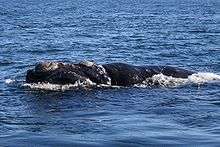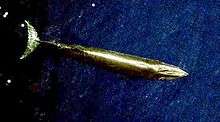List of mammals of New Zealand
This is a list of the native mammals of New Zealand.[1] It does not include introduced species.
Conservation status
The following tags are used to highlight each species' conservation status as assessed by the IUCN:
| EX | Extinct | No reasonable doubt that the last individual has died. |
| EW | Extinct in the wild | Known only to survive in captivity or as a naturalized population well outside its previous range. |
| CR | Critically endangered | The species is in imminent risk of extinction in the wild. |
| EN | Endangered | The species is facing an extremely high risk of extinction in the wild. |
| VU | Vulnerable | The species is facing a high risk of extinction in the wild. |
| NT | Near threatened | The species does not meet any of the criteria that would categorise it as risking extinction but it is likely to do so in the future. |
| LC | Least concern | There are no current identifiable risks to the species. |
| DD | Data deficient | There is inadequate information to make an assessment of the risks to this species. |
Some species were assessed using an earlier set of criteria. Species assessed using this system have the following instead of near threatened and least concern categories:
| LR/cd | Lower risk/conservation dependent | Species which were the focus of conservation programmes and may have moved into a higher risk category if that programme was discontinued. |
| LR/nt | Lower risk/near threatened | Species which are close to being classified as vulnerable but are not the subject of conservation programmes. |
| LR/lc | Lower risk/least concern | Species for which there are no identifiable risks. |
Order: Chiroptera (bats)
The most distinguishing feature of bats is that their forelimbs are developed as wings, making them the only mammals in the world naturally capable of flight. Bat species account for about 20% of all mammals.
- Family: Mystacinidae
- Genus: Mystacina
- New Zealand greater short-tailed bat, Mystacina robusta CR
- New Zealand lesser short-tailed bat, Mystacina tuberculata VU
- Genus: Mystacina
- Family: Vespertilionidae
- Subfamily: Vespertilioninae
- Genus: Chalinolobus
- New Zealand long-tailed bat, Chalinolobus tuberculatus VU
- Genus: Chalinolobus
- Subfamily: Vespertilioninae
Order: Cetacea (whales, dolphins and porpoises)


The order Cetacea includes whales, dolphins and porpoises. They are the mammals most fully adapted to aquatic life with a spindle-shaped nearly hairless body, protected by a thick layer of blubber, and forelimbs and tail modified to provide propulsion underwater. New Zealand is the first country in the world to protect marine mammals by law.
- Suborder: Mysticeti
- Family: Balaenidae
- Genus: Eubalaena
- Southern right whale, Eubalaena australis LR/cd (nationally endangered)
- Genus: Eubalaena
- Family: Balaenopteridae
- Subfamily: Balaenopterinae
- Genus: Balaenoptera
- Minke whale, Balaenoptera acutorostrata LR/nt
- Bryde's whale, Balaenoptera edeni DD
- Sei whale, Balaenoptera borealis EN
- Fin whale, Balaenoptera physalus EN
- Blue whale, Balaenoptera musculus EN
- Genus: Balaenoptera
- Subfamily: Megapterinae
- Genus: Megaptera
- Humpback whale, Megaptera novaeangliae VU (lower numbers in New Zealand waters)
- Genus: Megaptera
- Subfamily: Balaenopterinae
- Family: Neobalaenidae
- Genus: Caperea
- Pygmy right whale, Caperea marginata LR/lc
- Genus: Caperea
- Family: Balaenidae
- Suborder: Odontoceti
- Superfamily: Platanistoidea
- Family: Phocoenidae
- Genus: Phocoena
- Spectacled porpoise, Phocoena dioptrica DD
- Genus: Phocoena
- Family: Physeteridae
- Genus: Physeter
- Sperm whale, Physeter macrocephalus VU
- Genus: Physeter
- Family: Kogiidae
- Genus: Kogia
- Pygmy sperm whale, Kogia breviceps LR/lc
- Dwarf sperm whale, Kogia sima LR/lc
- Genus: Kogia
- Family: Ziphidae
- Genus: Ziphius
- Cuvier's beaked whale, Ziphius cavirostris DD
- Genus: Berardius
- Arnoux's beaked whale, Berardius arnuxii LR/cd
- Genus: Tasmacetus
- Shepherd's beaked whale, Tasmacetus shepherdi DD
- Subfamily: Hyperoodontinae
- Genus: Hyperoodon
- Southern bottlenose whale, Hyperoodon planifrons LR/cd
- Genus: Mesoplodon
- Andrews' beaked whale, Mesoplodon bowdoini DD
- Blainville's beaked whale, Mesoplodon densirostris DD
- Ginkgo-toothed beaked whale, Mesoplodon ginkgodens DD
- Gray's beaked whale, Mesoplodon grayi DD
- Hector's beaked whale, Mesoplodon hectori DD
- Layard's beaked whale, Mesoplodon layardii DD
- Genus: Hyperoodon
- Genus: Ziphius
- Family: Delphinidae (marine dolphins)
- Genus: Cephalorhynchus
- Hector's dolphin, Cephalorhynchus hectori EN (endemic, endangered)
- Maui's dolphin, Cephalorhynchus hectori maui CR (endemic, critically endangered)
- Genus: Steno
- Rough-toothed dolphin, Steno bredanensis DD
- Genus: Stenella
- Pantropical spotted dolphin, Stenella attenuata LR/cd
- Striped dolphin, Stenella coeruleoalba LR/cd
- Spinner dolphin, Stenella longirostris LR/cd
- Genus: Delphinus
- Common dolphin, Delphinus capensis LR/lc
- Common dolphin, Delphinus delphis LR/lc
- Genus: Lagenorhynchus
- Hourglass dolphin, Lagenorhynchus cruciger LR/lc
- Dusky dolphin, Lagenorhynchus obscurus DD
- Genus: Lissodelphis
- Southern right whale dolphin, Lissodelphis peronii DD
- Genus: Grampus
- Risso's dolphin, Grampus griseus DD
- Genus: Pseudorca
- False killer whale, Pseudorca crassidens LR/lc
- Genus: Orcinus
- Orca, Orcinus orca LR/cd
- Genus: Globicephala
- Short-finned pilot whale, Globicephala macrorhynchus LR/cd
- Long-finned pilot whale, Globicephala melas LR/lc
- Genus: Cephalorhynchus
- Family: Phocoenidae
- Superfamily: Platanistoidea
Order: Carnivora (carnivorans)
Typical carnivorans feed primarily on meat. They have a characteristic skull shape and teeth.
- Suborder: Caniformia
- Family: Otariidae (eared seals, sealions)
- Genus: Arctocephalus
- New Zealand fur seal, Arctocephalus forsteri LR/lc
- Subantarctic fur seal, Arctocephalus tropicalis LR/lc
- Genus: Phocarctos
- New Zealand sea lion, Phocarctos hookeri VU
- Genus: Arctocephalus
- Family: Phocidae (earless seals)
- Genus: Hydrurga
- Leopard seal, Hydrurga leptonyx LR/lc
- Genus: Leptonychotes
- Weddell seal, Leptonychotes weddellii LR/lc
- Genus: Lobodon
- Crabeater seal, Lobodon carcinophaga LR/lc
- Genus: Mirounga
- Southern elephant seal, Mirounga leonina LR/lc
- Genus: Hydrurga
- Family: Otariidae (eared seals, sealions)
See also
Notes
- ↑ This list is derived from the IUCN Red List which lists species of mammals and includes those mammals that have recently been classified as extinct (since 1500 AD). The taxonomy and naming of the individual species is based on those used in existing Wikipedia articles as of 21 May 2007 and supplemented by the common names and taxonomy from the IUCN, Smithsonian Institution, or University of Michigan where no Wikipedia article was available.
References
- "The IUCN Red List of Threatened Species: Mammals of New Zealand". IUCN. 2001. Retrieved 22 May 2007.
- "Mammal Species of the World". Smithsonian National Museum of Natural History. 2005. Archived from the original on 27 April 2007. Retrieved 22 May 2007.
- "Animal Diversity Web". University of Michigan Museum of Zoology. 1995–2006. Retrieved 22 May 2007.




